8 incredible homes that were picked up and moved
Bringing new meaning to moving house
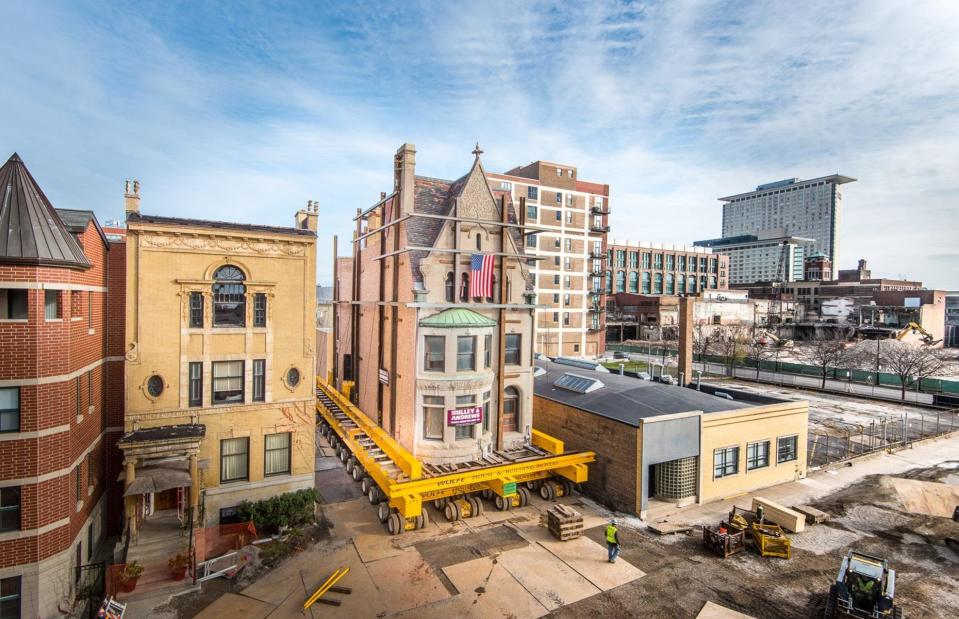
Wolfe House & Building Movers
Moving home can be an expensive, complicated and stressful process, so imagine the organisation and work it takes to physically move a house from one plot to another.
From the restless former country estate of Alexander Hamilton to a rustic stone cottage that travelled almost 11,000 miles (17,702km) from England to Australia, all of these amazing abodes have been packed up and transported somewhere new.
Read on to discover how – and why – these historic properties were given new homes...
Henry Ford's Cotswold cottage, Michigan, USA
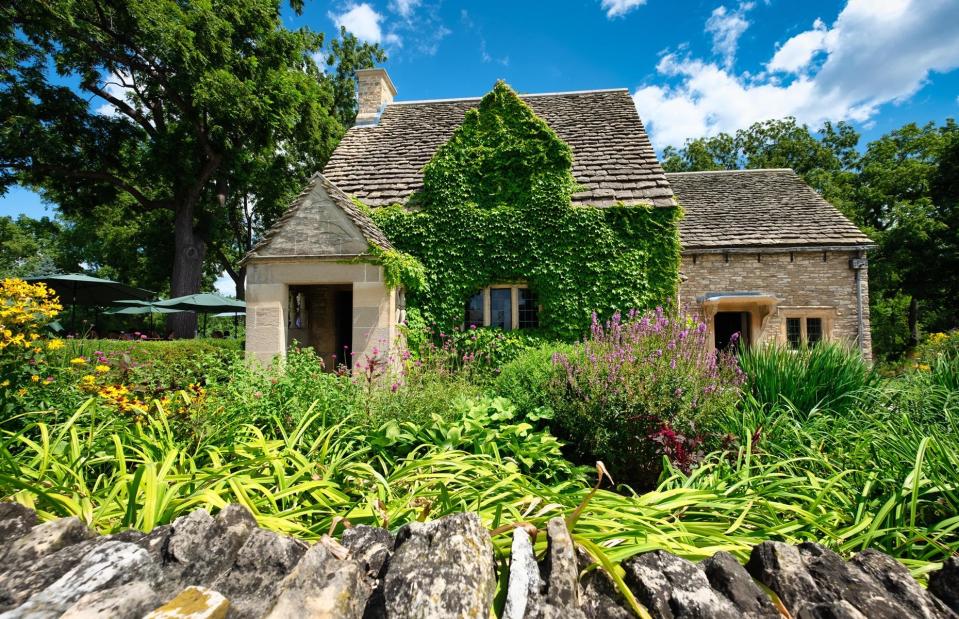
Amy Cicconi / Alamy Stock Photo
While this quaint cottage looks like it belongs in the heart of the English Cotswolds, in reality it’s a long way from home, situated in the living history museum of Greenfield Village, Michigan.
The 1619 cottage was transported across the Atlantic in 1929 by one of America’s richest men, Henry Ford, who had fallen deeply in love with the scenic Cotswolds during several visits in the early 1920s.
Henry Ford's Cotswold cottage, Michigan, USA
![<p>Michael Barera / Wikimedia Commons [CC BY-SA 4.0]</p>](https://s.yimg.com/ny/api/res/1.2/fmRX_mSgAiMJpEuNbKAwqA--/YXBwaWQ9aGlnaGxhbmRlcjt3PTk2MDtoPTYxOQ--/https://media.zenfs.com/en/loveproperty_uk_165/d19da89fba500d9158225b711d760de5)
Michael Barera / Wikimedia Commons [CC BY-SA 4.0]
Ford became so enamoured with the distinctive golden-bricked cottages that he decided he simply had to have one for himself. He found one to his liking and paid to have it deconstructed and shipped all the way to his home and manufacturing centre in Michigan.
Here, the house was then painstakingly reconstructed brick by brick; a total of 475 tonnes (430,900kg) of stone, glass and wood to be precise. He's even said to have taken a couple of Cotswold sheep back with him, too!
Henry Ford's Cotswold cottage, Michigan, USA
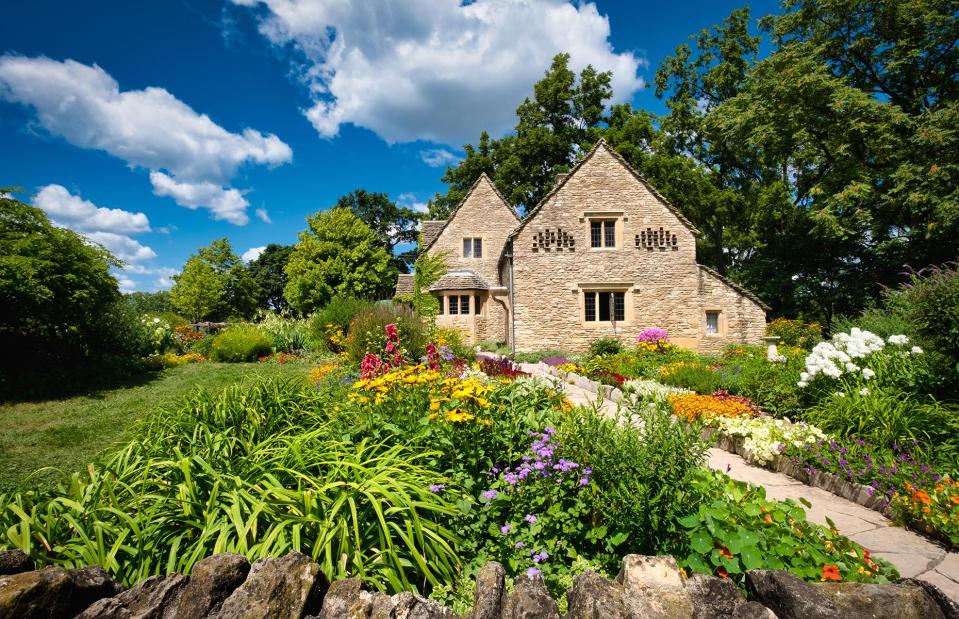
Amy Cicconi / Alamy Stock Photo
The time capsule home became part of a larger project for Ford – Greenfield Village – in which Ford collected, transported and reconstructed a series of historic homes from all over the United States.
The idea was to turn the community into an immersive, living history museum, where visitors could come and experience everyday 19th-century American village life.
Henry Ford's Cotswold cottage, Michigan, USA
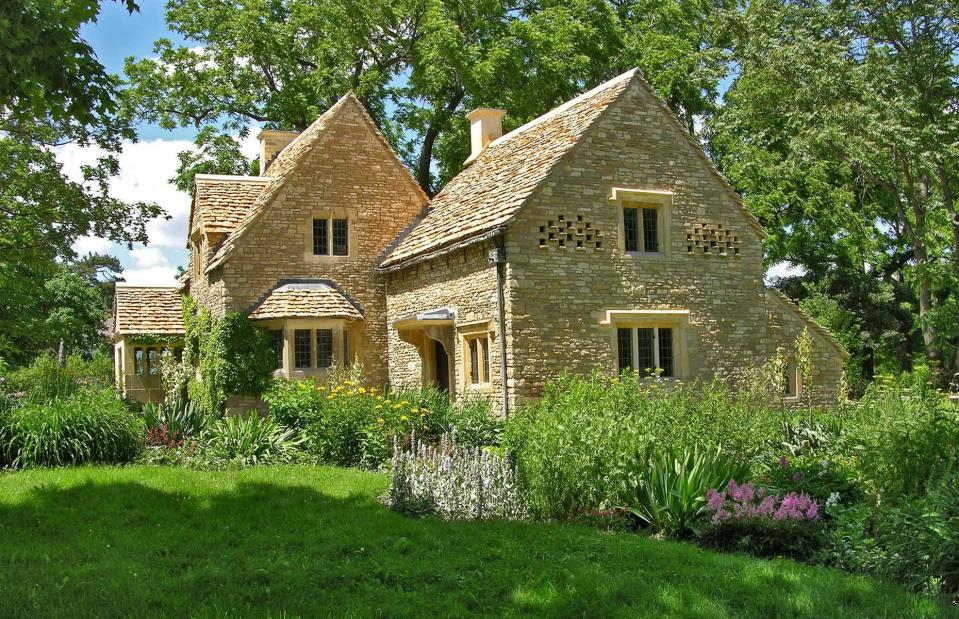
Dennis MacDonald / Alamy Stock Photo
Of course, the Cotswold cottage is both from the wrong country and the wrong century to fit with the rest of the museum, but it has at least been painstakingly restored to preserve its 17th-century architectural details. The home includes traditional flagstone flooring, stone fireplaces, mullioned windows and beamed ceilings and its external wall even boasts a dove coat typical of country cottages from the period.
Jim Johnson, director of Greenfield Village, told the BBC the project was "without doubt the most expensive" of any within in village. Today, the cottage remains open to the public as part of the museum and receives thousands of visitors every year.
Seaview Terrace, Rhode Island, USA
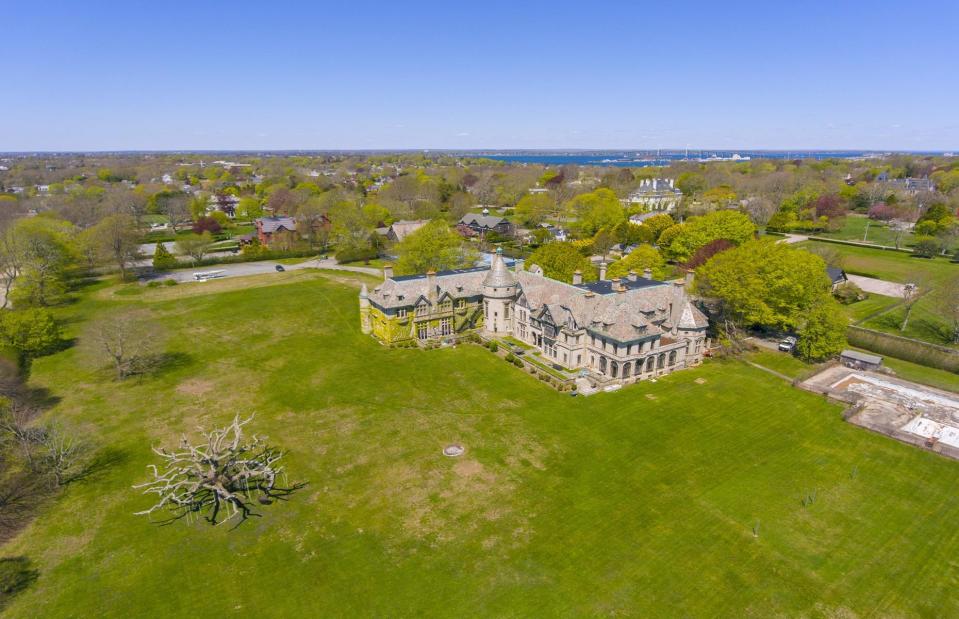
Wangkun Jia / Shutterstock
Seaview Terrace can be found in the wealthy city of Newport, Rhode Island, on a stunning eight-acre (3.2ha) plot overlooking scenic Sheep Point Cove.
Also known as the Carey Mansion, the 43,700-square-foot (4,059 sqm) waterfront property is the area's fifth-largest estate, after the likes of Belcourt Castle and The Breakers. But more impressive than its breathtaking scale is that it was moved more than 400 miles in 1923.
Seaview Terrace, Rhode Island, USA
![<p>Paulhaberstroh / Wikimedia Commons [CC BY-SA 4.0]</p>](https://s.yimg.com/ny/api/res/1.2/jlLZ_ehXXjxM_ZZsJc.8Fg--/YXBwaWQ9aGlnaGxhbmRlcjt3PTk2MDtoPTYxOQ--/https://media.zenfs.com/en/loveproperty_uk_165/42711c7ccf2f4a55ac52df9feb38950e)
Paulhaberstroh / Wikimedia Commons [CC BY-SA 4.0]
The colossal mansion was constructed in the popular residential neighbourhood of Dupont Circle, Washington, D.C., in 1907, for wealthy distiller, Edson Bradley, who later hired architect Howard Greenley to renovate and enlarge the home.
The property reportedly grew to 16,000 square feet (1,486sqm) and covered over half a city block. Yet Bradley seemingly became dissatisfied with the location and in 1923, decided to disassemble the house and move it to Newport.
Seaview Terrace, Rhode Island, USA
![<p>Reading Tom / Flickr [CC BY 2.0]</p>](https://s.yimg.com/ny/api/res/1.2/nBMg8zoE2AWWMzAqtNFTZg--/YXBwaWQ9aGlnaGxhbmRlcjt3PTk2MDtoPTYxOQ--/https://media.zenfs.com/en/loveproperty_uk_165/e10b910de9120aab5d4de5e7d49c55e6)
Reading Tom / Flickr [CC BY 2.0]
The process is said to have taken two years and the project received plenty of notoriety, even gaining a mention in Ripley’s Believe It or Not – an entertainment franchise dedicated to the world’s most unusual events and items.
What makes the move even more astonishing are the parts of the house that were dissembled and reconstructed, such as the estate's private chapel, art gallery, a 500-seat theatre and a ballroom, kitted out with ornate detailing.
Seaview Terrace, Rhode Island, USA
![<p>Paulhaberstroh / Wikimedia Commons [CC BY-SA 4.0]</p>](https://s.yimg.com/ny/api/res/1.2/SxtY_gAeMGbwNcj2IgVZDg--/YXBwaWQ9aGlnaGxhbmRlcjt3PTk2MDtoPTYxOQ--/https://media.zenfs.com/en/loveproperty_uk_165/37c8f59afbaee1d84103993f9752aee4)
Paulhaberstroh / Wikimedia Commons [CC BY-SA 4.0]
All of the home's furnishings and interior fixtures, mostly imported from France, also made the trip, including highly decorative, hand-carved ceilings and stone staircases. Yet the building’s most prized asset is perhaps a stained glass window dating from the early Renaissance that was originally designed for the Duomo Cathedral in Milan, Italy. After moving the property, Bradley bought an Elizabethan Revival mansion known as Sea View and together the two homes formed Seaview Terrace.
Today, the estate is the largest privately owned home in Newport. It straddles two addresses in one of the area's most sought-after zip codes, boasts 29 bedrooms, 18 bathrooms, a whispering gallery and a two-storey entrance hall, kitted out with medieval-inspired fixtures. Even now, Seaview Terrace remains one of the largest homes to ever be dismantled and reassembled elsewhere.
Cooks' Cottage, Victoria, Australia
![<p>Rexness / Flickr [CC BY-SA 2.0]</p>](https://s.yimg.com/ny/api/res/1.2/EKqnUhMSCLK2O2pLoaOZ7Q--/YXBwaWQ9aGlnaGxhbmRlcjt3PTk2MDtoPTYxOQ--/https://media.zenfs.com/en/loveproperty_uk_165/ce8eaae55dafc746be40a3fadbc49779)
Rexness / Flickr [CC BY-SA 2.0]
Even though this chocolate box cottage was constructed in a quaint village in North Yorkshire, England, it can now be found more than 10,500 miles (16,898km) away in Melbourne, Australia.
As a home with a fascinating history and a remarkable journey under its belt, this charming property is one of the world's most interesting pieces of architecture. Cooks' Cottage, also known as Captain Cook's Cottage, was constructed in 1755 by the parents of British explorer, Captain James Cook.
Cooks' Cottage, Victoria, Australia
![<p>Rexness / Flickr [CC BY-SA 2.0]</p>](https://s.yimg.com/ny/api/res/1.2/r9guWWNKntSE3ymbq8x9yw--/YXBwaWQ9aGlnaGxhbmRlcjt3PTk2MDtoPTYxOQ--/https://media.zenfs.com/en/loveproperty_uk_165/9296949a577194267eef54b903dd5354)
Rexness / Flickr [CC BY-SA 2.0]
The Cooks bought the land in Great Ayton, North Yorkshire, for a mere "twenty-six lawfull shillings" and built two homes – one to live in and one to rent out, according to Great Ayton Parish Council. After his wife Grace passed away in 1772, James Cook Senior moved to the town of Redcar on the Yorkshire Coast.
In 1907, the Dixon Brothers, who owned a grocery store in Great Ayton, purchased the two properties and rented them both out. Sadly, almost all of the western cottage was demolished in 1928, when Easby Lane was widened.
Cooks' Cottage, Victoria, Australia
![<p>SuperJew / Wikimedia Commons [CC BY-SA 4.0]</p>](https://s.yimg.com/ny/api/res/1.2/VOcLzn4O2c4QbE8E570xCA--/YXBwaWQ9aGlnaGxhbmRlcjt3PTk2MDtoPTYxOQ--/https://media.zenfs.com/en/loveproperty_uk_165/a9e2cbea2d4cc54e5f712fe3e02e5ac7)
SuperJew / Wikimedia Commons [CC BY-SA 4.0]
By the 1930s, the house had been abandoned. It was placed for auction with a condition of sale that stated the building must remain in England. The property received a single bid of £300 ($377), which equates to around £24,574 ($31k) in today’s money, before an Australian buyer stepped in and offered £800 ($1k), or £55,650 ($83k) today.
Understandably, the condition of the sale was dropped, leaving the home open to relocation. In 1934 the new owner, Sir Russell Grimwade, dismantled the house and transported it by ship to Fitzroy Gardens, Melbourne, donating it to the State of Victoria. According to the Captain Cook Society, the cottage was demolished brick by brick and packed into 253 cases and 40 barrels, along with the ivy from the building's external walls.
Cooks' Cottage, Victoria, Australia
![<p>SuperJew / Wikimedia Commons [CC BY-SA 4.0]</p>](https://s.yimg.com/ny/api/res/1.2/SzWYZh0NPIxuH.6MdfwPQQ--/YXBwaWQ9aGlnaGxhbmRlcjt3PTk2MDtoPTYxOQ--/https://media.zenfs.com/en/loveproperty_uk_165/2e87c111b1741fdec8e9f31cdfc9a6f1)
SuperJew / Wikimedia Commons [CC BY-SA 4.0]
Once rebuilt, the home was opened to the public and quickly became a popular attraction. It was restored in 1978 and remains a local landmark to this day.
If you ever find yourself in Great Ayton, you can visit the place where Cook's home once stood. In its place, you'll find The Cook Family Memorial Garden, which was created in 1934 after the house was relocated. Ironically, the great explorer never actually lived in the cottage.
Hamilton Grange, New York, USA
![<p>Robert Cutts / Flickr [CC BY 2.0]</p>](https://s.yimg.com/ny/api/res/1.2/xcoQehmA1bQ8dYxdMBWEsQ--/YXBwaWQ9aGlnaGxhbmRlcjt3PTk2MDtoPTYxOQ--/https://media.zenfs.com/en/loveproperty_uk_165/0bb34f86fc7c2873b004714dfee39158)
Robert Cutts / Flickr [CC BY 2.0]
Incredibly, this federal-style country home has been moved not once, but twice. It was designed by architect John McComb Junior back in 1802 for Alexander Hamilton, one of the Founding Fathers of the United States.
The house was named The Grange, after the Hamilton family's ancestral home in Scotland, UK, and was positioned on what would then have been a country estate on the outskirts of Manhattan, but is now part of built-up Hamilton Heights in Harlem.
Hamilton Grange, New York, USA
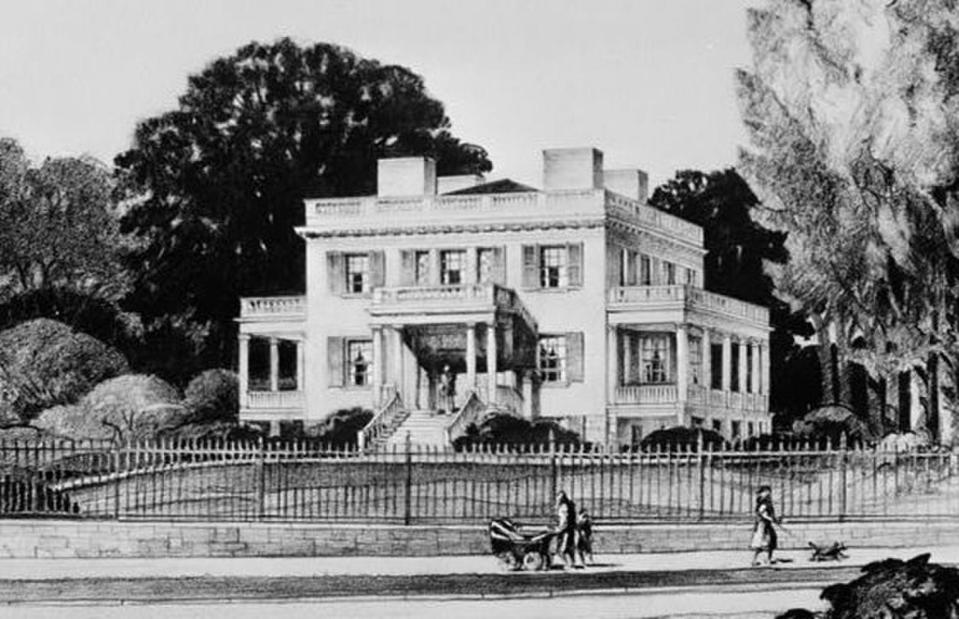
United States Library of Congress / Public Domain
This historic image shows the stately home in its original position, on 237 West 141 Street, New York City. The property was the only one that Hamilton ever owned and he only lived there for two years, before he lost a duel with Aaron Burr (who was then the Vice President of the United States) in July 1804.
By 1889 the property belonged to the National Park Service, who decided to move the house to Convent Avenue in Harlem, since new, towering buildings had begun to overwhelm the important historic monument.
Hamilton Grange, New York, USA
![<p>Robert Cutts / Flickr [CC BY 2.0]</p>](https://s.yimg.com/ny/api/res/1.2/bQNJET5xXbVHl39ngI6nMA--/YXBwaWQ9aGlnaGxhbmRlcjt3PTk2MDtoPTYxOQ--/https://media.zenfs.com/en/loveproperty_uk_165/3ff0395d4660a32a2915ad2e46940067)
Robert Cutts / Flickr [CC BY 2.0]
Then, in June 2008, the National Park Service decided to move the home once again. The structure was relocated two blocks over, to a leafy hillside lot in St. Nicholas Park, West Harlem, which was once part of Hamilton’s estate.
For the first time in 119 years, all four sides of the home were visible. Following the move, the missing original entranceway, exterior porches and architectural features were restored, before the house was reopened to the public.
According to the National Park Service, the process took 38 days, from the time the house was separated from its foundations to when it was delivered to its current plot. The house was sandwiched between a church and an apartment building, which made the job even harder.
Hamilton Grange, New York, USA

National Parks Gallery / Public Domain / PICRYL
Amazingly, there are images of the property mid-move. Wolfe House & Building Movers of Pennsylvania took on the task and had to lift the house 38 feet (12m) vertically, to roll it out onto a loggia and shift it through the streets.
To achieve this, the movers used hydraulic jacks to elevate the property, while reducing stress on the historic building. An estimated 7,000 pieces of cribbing and almost two miles (3.2km) of chain were used to support the property during the move.
Harriet F. Rees House, Illinois, USA
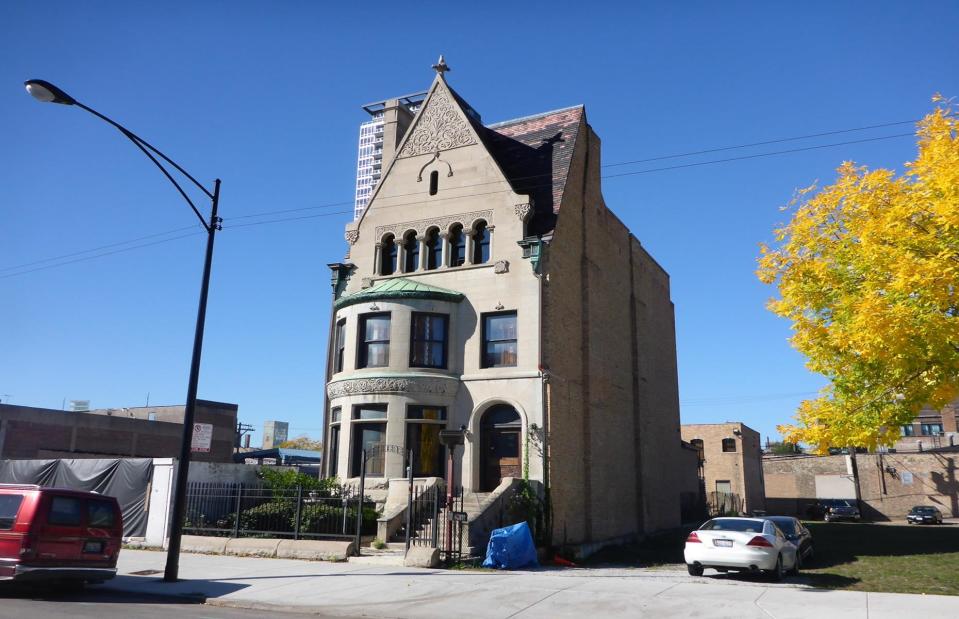
Wolfe House & Building Movers
This Romanesque Revival limestone mansion was built in 1888 on Prairie Avenue, which at the time was one of Chicago’s most prestigious residential neighbourhoods. It was one of the last family homes to be constructed on the block and was wedged into a narrow parcel that was just 24 feet (7.3m) wide.
Yet by 2012, it was only one of seven historic homes still standing on the once affluent street and the only one remaining on its block. So, what happened?
Harriet F. Rees House, Illinois, USA
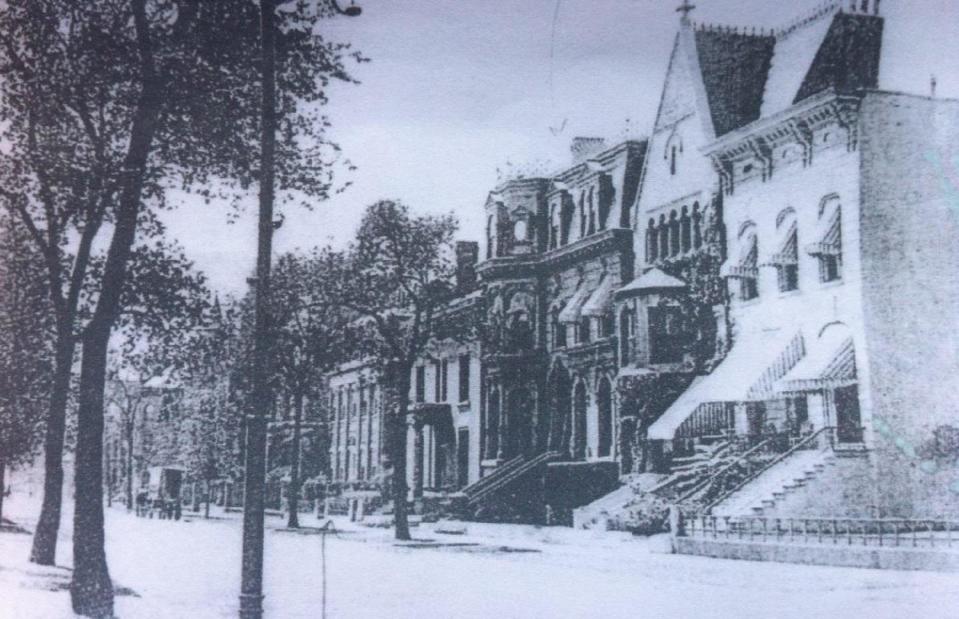
Public Domain
This image shows how Prairie Avenue looked during its heyday – it was a desirable place to live, filled with large homes for affluent families. The property was designed by renowned architects Cobb & Frost for Harriet F. Rees, the widow of real estate pioneer and land surveyor, James H. Rees.
Harriet resided at the property for four years, until she sadly passed away at the age of 75 in 1892. Later, the building was used as a restaurant, until it was purchased in 2001.
Harriet F. Rees House, Illinois, USA
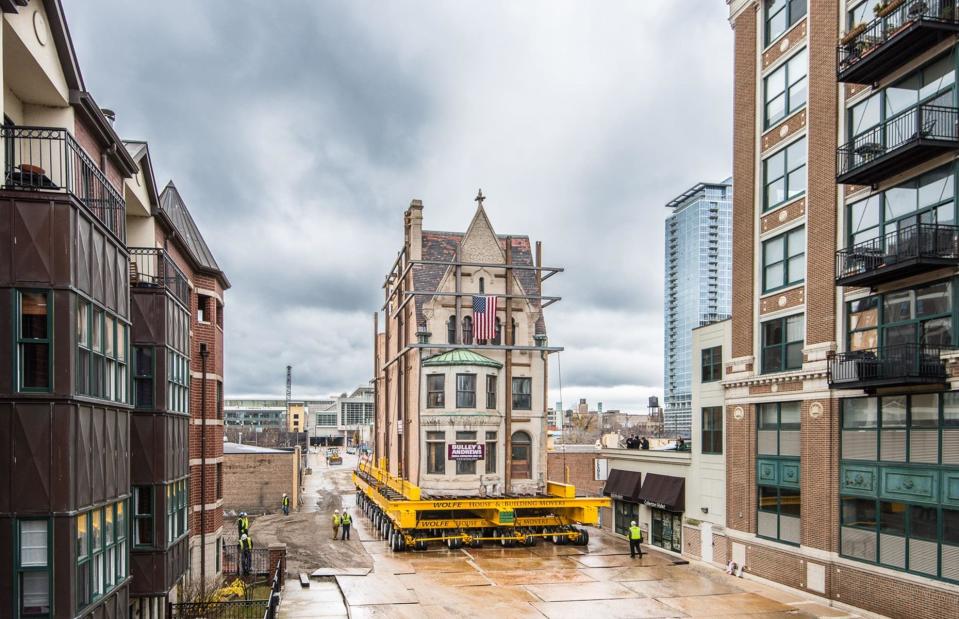
Wolfe House & Building Movers
Harriet Rees spared no expense when she commissioned the property. It features an ornate limestone exterior and an interior decorated with rich woods, distinctive fireplaces, a unique staircase and other one-of-a-kind built-ins. The house also featured one of the first residential elevators in the city. In 2012, the property was given City of Chicago landmark status and added to the National Register of Historic Places.
Then, more than 125 years after it was completed, Harriet F. Rees House was threatened by the development of the McCormick Place entertainment district. To preserve the building, the Commission on Chicago Landmarks agreed to allow the property and its adjoining carriage house to be shifted to a new location.
Harriet F. Rees House, Illinois, USA
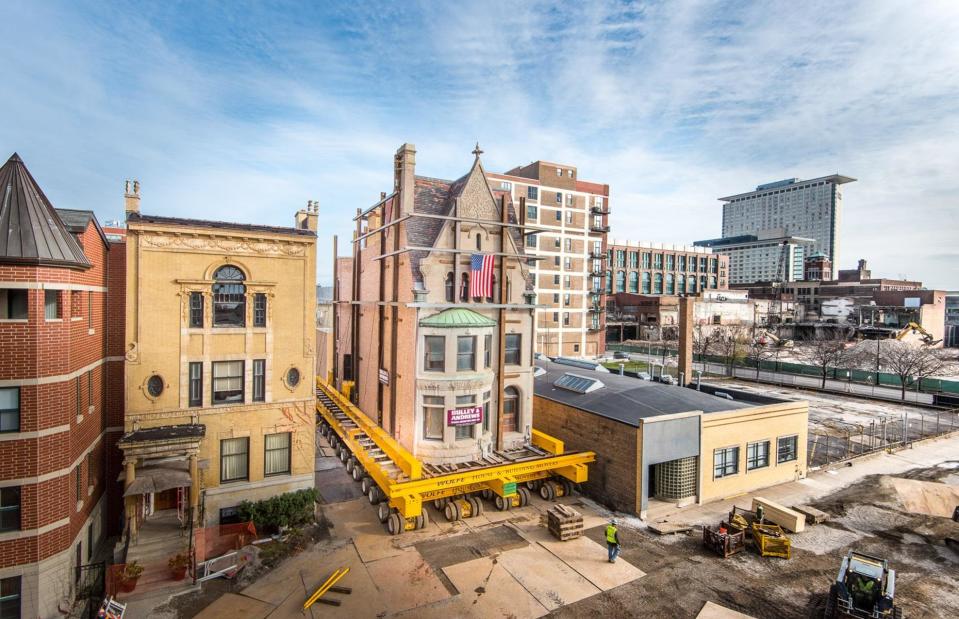
Wolfe House & Building Movers
In 2014, the team at Wolfe House & Building Movers transported the buildings to their current location at 2017 S. Prairie Avenue, just across the street. This image shows the main residence being slotted into its final position.
According to the Chicago Architecture Center, the project cost approximately £4.7 million ($6m). The Metropolitan Pier and Exposition Authority, which was overseeing the development of the entertainment district, was forced to pay up and even had to fork out £1.5 million ($1.9m) for the home's new plot.
Agecroft Hall, Virginia, USA
![<p>Phoebe Reid / Flickr [CC BY 2.0]</p>](https://s.yimg.com/ny/api/res/1.2/lqjsYpHLj6_QLqTVeDBWSg--/YXBwaWQ9aGlnaGxhbmRlcjt3PTk2MDtoPTYxOQ--/https://media.zenfs.com/en/loveproperty_uk_165/15fef257eb94cf1f2dd66f9f64c468d0)
Phoebe Reid / Flickr [CC BY 2.0]
Remarkably, Cooks' Cottage isn't the only historic building that has been transported not a few streets away, but several thousand miles away. Known as Agecroft Hall, this medieval manor house dates back as far as 1291 and was originally constructed in the idyllic town of Pendlebury, which at the time stood in the county of Lancashire, England.
During the 13th century, the manor belonged to Adam de Prestwich and his wife, Cecily. It was passed onto the couple’s granddaughter, Margaret, when Adam and Cecily fell victim to the bubonic plague in 1349.
Agecroft Hall, Virginia, USA
![<p>Richerman / Wikimedia [Public Domain]</p>](https://s.yimg.com/ny/api/res/1.2/NFxzElMaZA0oXp.nHzyuLQ--/YXBwaWQ9aGlnaGxhbmRlcjt3PTk2MDtoPTYxOQ--/https://media.zenfs.com/en/loveproperty_uk_165/400c4af797d82eccb599193cc1ecc108)
Richerman / Wikimedia [Public Domain]
Tragically, Margaret also passed away from the plague shortly after. Centuries later, when the Irwell Valley coal mines were opened in the 19th century, railway tracks were constructed across the estate, which soon led to its abandonment.
By the 20th century, the sprawling property had fallen into a state of disrepair. This photograph shows the original Agecroft Hall in Pendlebury before it was left to decay. Luckily, the impressive property was rescued in 1925, by wealthy entrepreneur Thomas C. Williams Junior.
Agecroft Hall, Virginia, USA
![<p>Fopseh / Wikimedia [CC BY-SA 3.0]</p>](https://s.yimg.com/ny/api/res/1.2/zHgpPsacyc5PokP4FV7W.Q--/YXBwaWQ9aGlnaGxhbmRlcjt3PTk2MDtoPTYxOQ--/https://media.zenfs.com/en/loveproperty_uk_165/1270c21ae69fe3efb813c037d4933b40)
Fopseh / Wikimedia [CC BY-SA 3.0]
Williams was keen to build an English-style country estate on his 23-acre (9.3ha) plot overlooking the James River in Richmond, Virginia, but Agecroft Hall provided him with the chance to own a real-life English estate. The manor house was dismantled, crated and transported across the Atlantic Ocean, before being reconstructed in Richmond.
Architect Henry G. Morse took on the colossal reconstruction project, but changed the floorplan and added plenty of modern conveniences to render the house more suitable for 20th-century living.
Agecroft Hall, Virginia, USA
![<p>Kelly Verdeck / Flickr [CC BY-ND 2.0]</p>](https://s.yimg.com/ny/api/res/1.2/eyx78AGVyQu4PngJidLJdQ--/YXBwaWQ9aGlnaGxhbmRlcjt3PTk2MDtoPTYxOQ--/https://media.zenfs.com/en/loveproperty_uk_165/f0dbb9cb6b54a2384044576474d43133)
Kelly Verdeck / Flickr [CC BY-ND 2.0]
The reconstruction project took two years and was finished in 1928. It’s thought to have cost £198,000 ($250k), roughly £3.6 million ($4.6m) in today’s money. Tragically, Williams passed away the following year and after his wife subsequently did too, the property was turned into the Agecroft Hall and Gardens museum.
Inside, it boasts many original features, from panelled walls and leaded lattice windows to artwork, antique furnishings and grand four-poster beds. Agecroft's grounds were inspired by classic English gardens and were designed by iconic landscape architect Charles Gillette with Elizabethan themes in mind. The gatehouse is all that remains of the original Agecroft Estate in the United Kingdom.
Thomas Isaac Log Cabin, Maryland, USA
![<p>Chris_Doig / Wikimedia [Public Domain]</p>](https://s.yimg.com/ny/api/res/1.2/9K5KJO1jdDKoyQEwCmrdlQ--/YXBwaWQ9aGlnaGxhbmRlcjt3PTk2MDtoPTYxOQ--/https://media.zenfs.com/en/loveproperty_uk_165/2573037e2acd5b276544092c63adbe98)
Chris_Doig / Wikimedia [Public Domain]
From the outside, it's clear that Thomas Isaac Log Cabin in Ellicott City, Maryland, has a rich history. Yet you'd likely never guess that the property was originally built somewhere else entirely.
Thomas Isaac Log Cabin, Maryland, USA
![<p>Mr.TinMD / Flickr [CC BY-ND 2.0]</p>](https://s.yimg.com/ny/api/res/1.2/mVhc9XQ5_oB2HXJoB_E_WA--/YXBwaWQ9aGlnaGxhbmRlcjt3PTk2MDtoPTYxOQ--/https://media.zenfs.com/en/loveproperty_uk_165/f9f4bc8f24e199a9ab37a6087485fdcd)
Mr.TinMD / Flickr [CC BY-ND 2.0]
The rustic cabin was constructed in around 1780 on Merryman Street, according to the Ellicott City Partnership. Considered an important landmark from the stages of European development in the Patapsco River Valley, the property was bought by Thomas Isaac in 1858, to expand his land holdings in the area.
It was also used as a meeting place and church by the city’s African American community during the 1870s.
Thomas Isaac Log Cabin, Maryland, USA
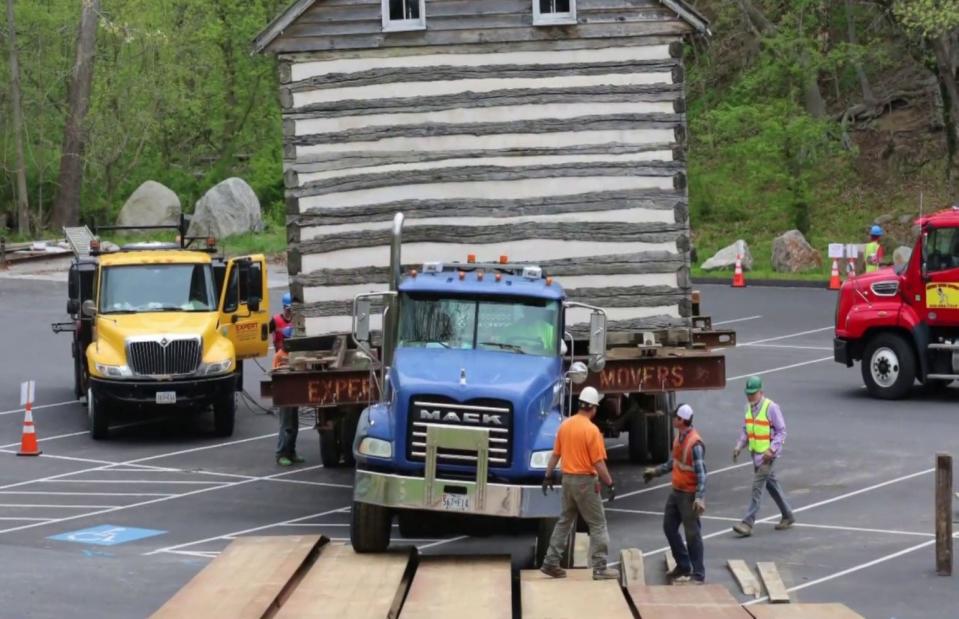
@Expert House Movers, Inc / YouTube
The cabin remained in the Isaac family until 1933, when John Henry Stanton snapped it up. He willed it to his wife, Fannie Jackson Stanton, in 1963. By the 1970s, the building sat vacant and was boarded up to deter vandals.
Seen as an important piece of architecture by Ellicott City, the property was dismantled and rebuilt at the intersection of Main Street and Ellicott Mills Drive in the 1980s. The house stood there for more than 30 years.
Thomas Isaac Log Cabin, Maryland, USA
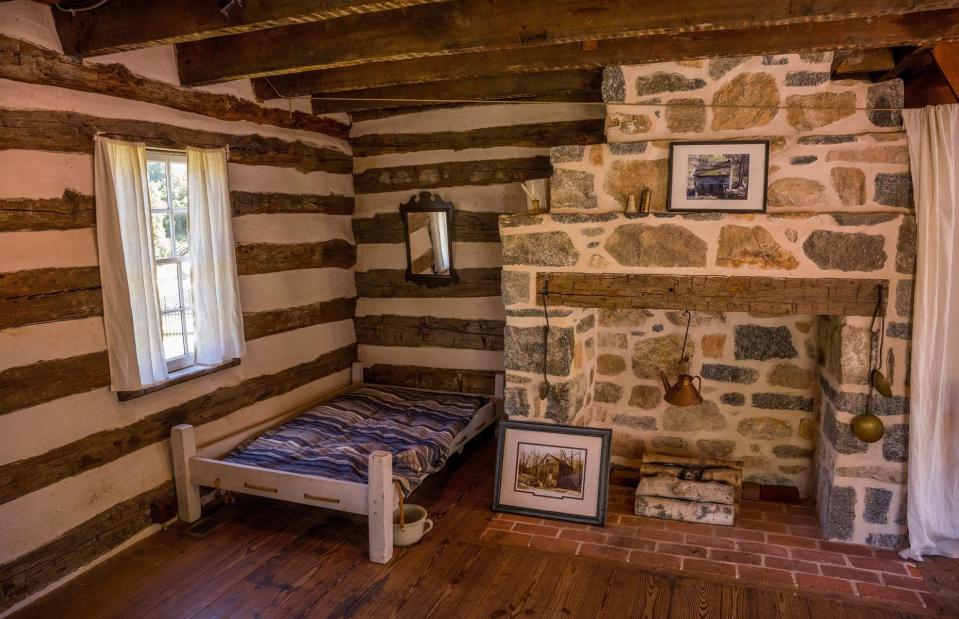
Wolfgang Kaehler / Alamy Stock Photo
Then, in 2018, a water pipe failed close by, causing flash flooding and extreme damage to the property. So, the tumbledown shack was temporarily moved to a parking lot, while the infrastructure at Ellicott Mills Drive was reconstructed.
Expert House Movers took on the job, lifting the cabin using manoeuvrable dollies and placing it on the back of a truck. The structure sat in its temporary location for 10 months, before it was returned to its former plot.
Today, Thomas Isaac Log Cabin is open to the public. Visitors can step inside the tiny home and take in its authentic historic interior, which reflects the style of most Maryland homes from the end of the 18th century, offering a glimpse into the state's colonial past.
Mäntylä, Pennsylvania, USA
![<p>Warren LeMay / Flickr [CC BY-SA 2.0]</p>](https://s.yimg.com/ny/api/res/1.2/TWuzeFBYmr0bfmoGQ3I.sw--/YXBwaWQ9aGlnaGxhbmRlcjt3PTk2MDtoPTYxOQ--/https://media.zenfs.com/en/loveproperty_uk_165/ca61acfa5ccab6e8e5e607c523fd2c96)
Warren LeMay / Flickr [CC BY-SA 2.0]
As perhaps America's most iconic architect, Frank Lloyd Wright is responsible for creating some of the country's most remarkable buildings, including Fallingwater and the Solomon R. Guggenheim Museum in New York City.
Mäntylä, also known as Lindholm House, was designed by Wright in 1952 and while it might not be his most impressive or famous creation, it has a remarkable story to tell.
Mäntylä, Pennsylvania, USA
![<p>Jeremy Thompson / Flickr [CC BY 2.0]</p>](https://s.yimg.com/ny/api/res/1.2/Rj0IUzAr9TYkqhOtBOcNnQ--/YXBwaWQ9aGlnaGxhbmRlcjt3PTk2MDtoPTYxOQ--/https://media.zenfs.com/en/loveproperty_uk_165/1573e9728ca010a194276252779dd4b7)
Jeremy Thompson / Flickr [CC BY 2.0]
The incredible home was originally positioned in the small town of Cloquet in Minnesota and was designed for businessman Ray Lindholm and his wife, Emmy. A fine example of one of Wright's late-period Usonian homes, it offered 2,300 square feet (214sqm) of inside space and a low, angular profile formed from concrete blocks and a Ludowici tile roof.
In 2016, the home’s owners, the McKinneys, turned to the Frank Lloyd Wright Building Conservancy to establish how they could ensure the property would remain intact for years to come.
Mäntylä, Pennsylvania, USA
![<p>Warren LeMay / Flickr [CC BY-SA 2.0]</p>](https://s.yimg.com/ny/api/res/1.2/qtv07jk4CdZtgFj6x3JA9Q--/YXBwaWQ9aGlnaGxhbmRlcjt3PTk2MDtoPTYxOQ--/https://media.zenfs.com/en/loveproperty_uk_165/e5bfa7f550946564f231c06ffee1938c)
Warren LeMay / Flickr [CC BY-SA 2.0]
It was placed on the market but failed to sell, so the McKinneys decided to donate the house to the Usonian Preservation, an organisation that owns a 130-acre (53ha) estate in Acme, Pennsylvania, where another relocated Wright design, the Duncan House, can also be found.
The property was carefully dismantled in the spring of 2016 and though its concrete blocks, floor slabs and roof rafters were demolished, the rest of the iconic house was packed onto the back of a lorry and driven 1,000 miles (1,609km) to Polymath Park, Acme.
Mäntylä, Pennsylvania, USA
![<p>Warren LeMay / Flickr [CC BY-SA 2.0]</p>](https://s.yimg.com/ny/api/res/1.2/SE97_mxb4N.BoAP9PRI3tw--/YXBwaWQ9aGlnaGxhbmRlcjt3PTk2MDtoPTYxOQ--/https://media.zenfs.com/en/loveproperty_uk_165/29023a8e9cb00590aa2ed9b54ac35e7c)
Warren LeMay / Flickr [CC BY-SA 2.0]
Open to visitors and overnight stays, architecture fans can take in the home's glorious mid-century modern interior, which is filled with timber-panelled walls, original built-ins and stylish furnishings. Amazingly, Mäntylä and Duncan House aren't the only Wright buildings that have been moved.
Wright designed Bachman-Wilson House in 1956, in Somerset County, New Jersey. In 1988 it was bought by the Tarantino family, who meticulously restored the property. However, due to its location next to the Millstone River, it was prone to flooding. So, in 2013 the Crystal Bridges Museum of American Art bought the house and relocated it 1,200 miles (1,931km) to Garland County, Arkansas.


